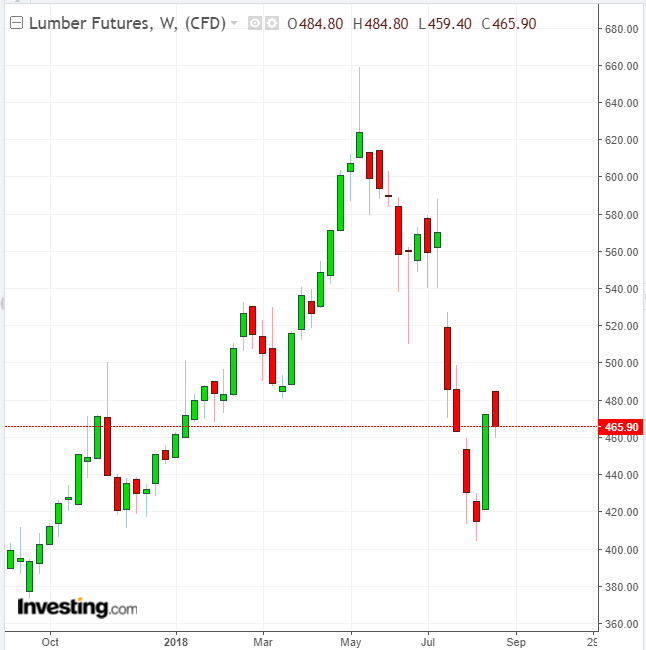After hitting the roof in May, US lumber hasn’t exactly plunged to bargain basement prices just yet. Clichés aside, however, a near 30-percent drop from the commodity's peak is indeed disastrous for anyone who bought at the highs.

The question for those individuals, and for would-be buyers of lumber, is whether the slide will continue.
Is it advisable to cut losses and exit, or just stay away for now? Or will the market remain volatile in the near-term? In other words, can lumber be considered as a hold or even a cautious buy? And is it also possible that prices have bottomed?
Should this be the case, it would mean, of course, that lumber is now a clearer buy than it was before. At Tuesday’s settlement of $467.90 per thousand foot board (mbf), lumber for September delivery on the Chicago Mercantile Exchange (CME) was nearly $200 below the record high of $659 set on May 14.
But on Investing.com’s daily technicals, it's deemed a “Strong Buy,” with sell indications only emerging beyond the 50-day moving average of $504.65. Fibonacci patterns peg Level 3 resistance for September lumber at $498.87, suggesting the contract has an upside of $30 before running into serious headwinds.
Commodity To Watch Rather Than Trade
When all is said and done though, this isn’t a market for the typical day trader or hedge fund. It’s debatable if even family offices and institutional funds are keen in taking long, passive positions here.
That’s because of the low volume and open interest that lumber suffers from. “In the wood futures market, these metrics are even lower than in the frozen concentrated orange juice market,” says veteran commodities trader Andrew Hecht. He describes lumber as “a commodity to watch rather than trade.”
While the CME values the North American physical lumber market at over $10 billion, lumber futures by open interest are worth less than $250 million. Each futures contract represents 110,000 board feet of wood, and the contract quote represents the wholesale price for 1,000 board feet.
Total open interest, a measure of liquidity from the number of open long and short positions, stood at 4,582 contracts as of August 20. The all-time high was set a decade ago at 14,403 contracts.
Daily volume in lumber futures has been around 1,300 contracts lately. For perspective, the average daily volume in US crude oil is around one million contracts, while open interest is above two million.
The reason lumber futures are more watchable than tradable is because those invested in them are primarily mills and producers and marketers of lumber and lumber products looking to minimize the risk of price fluctuations in construction-grade wood. Consumers, including homebuilders, furniture manufacturers and retailers, make up the other side of the market, as they seek fixed prices for their wood supplies.
Housing Market Harbinger
But lumber is also a harbinger of the US housing market, which, in turn, is a pillar of the world’s No. 1 economy. That makes it as important a commodity as any to watch. This year, particularly, wood futures have come under investors’ radar after the US imposed anti-dumping and anti-subsidy duties of 20 percent or more on lumber imports from Canada, lighting a flame under CME lumber that led to a 30 percent price hike on the year.
While softer US housing starts in July and August have forced lumber futures to retreat from those highs, investors in housing portfolios remain positive on the outlook for timber in general, given wood's indispensable status as a building material and expectations for higher inflation from at least two more US rate hikes this year. “The housing market credits have been doing very well, the ones we invest in specifically,” said Matt Kennedy, portfolio manager at the Angel Oak High Yield Opportunities Fund, which owns the debt of several home builders, suppliers, and distributors of home-building materials.
Kennedy said home builders in Angel Oak’s portfolio experienced strong sales despite this year’s pricier lumber.
“The communities they are selling in, there seems to be quite a bit of demand. Average home selling prices continue to grind higher with the higher lumber market, and they’ve been able to factor the higher costs into new home prices.”
At least two major US home builders have said that materials costs weren’t a major hindrance this year—meaning lumber prices could still rise. “Everyone knows the story behind lumber and its fluctuations, which are currently on the decline,” David Messenger, chief financial officer at Century Communities (NYSE:CCS), said during the company’s second quarter earnings call in early August.
“We focus on mitigating these increases through home price appreciation, national purchasing agreements, process efficiencies and long-term supplier and trade relationships. As we start new homes and underwrite new land acquisitions, we factor in cost inflation and higher interest cost into our assumption.”
Ryan R. Marshall, president of PulteGroup (NYSE:PHM), had a similar message to share at the company’s quarterly call with analysts last month. “When market dynamics include sustained demand and limited supply, prices will typically increase,” Marshall said. “This has certainly been the situation in housing for a number of years and has only continued as builders seek to pass through higher labor and material costs.”
